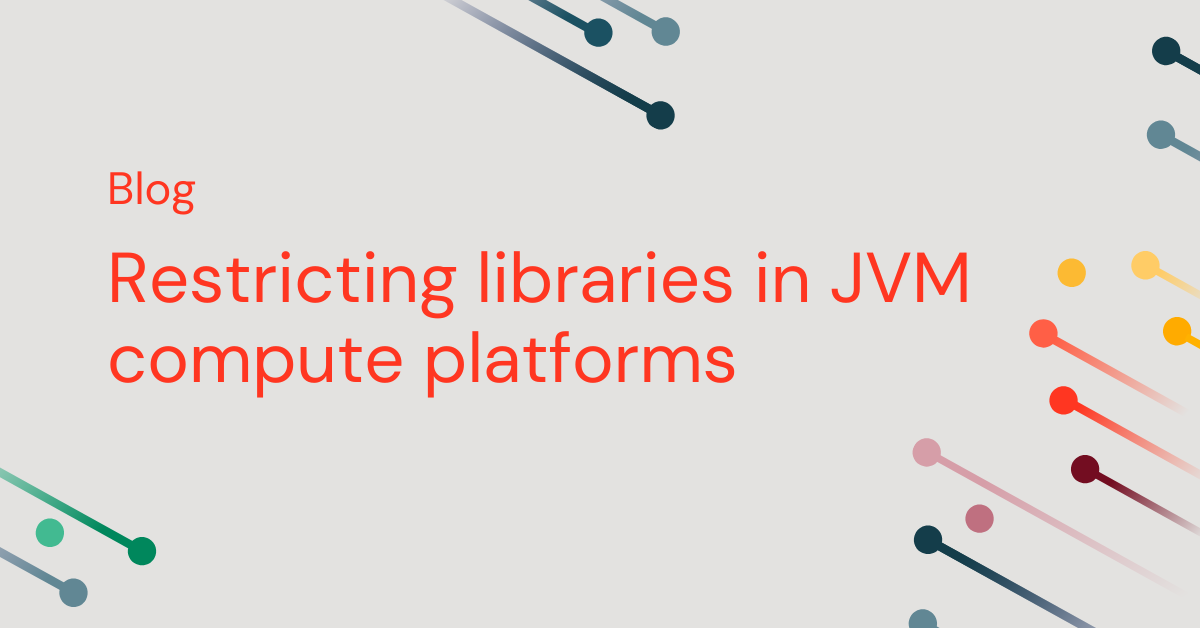Safety challenges with Scala and Java libraries
Open supply communities have constructed extremely helpful libraries. They simplify many frequent improvement situations. By our open-source initiatives like Apache Spark, we now have realized the challenges of each constructing initiatives for everybody and guaranteeing they work securely. Databricks merchandise profit from third celebration libraries and use them to increase current functionalities. This weblog submit explores the challenges of utilizing such third celebration libraries within the Scala and Java languages and proposes options to isolate them when wanted.
Third-party libraries typically present all kinds of options. Builders won’t pay attention to the complexity behind a selected performance, or know find out how to disable characteristic units simply. On this context, attackers can typically leverage surprising options to realize entry to or steal info from a system. For instance, a JSON library may use customized tags as a way to inappropriately permit inspecting the contents of native recordsdata. Alongside the identical strains, a HTTP library won’t take into consideration the danger of native community entry or solely present partial restrictions for sure cloud suppliers.
The safety of a 3rd celebration package deal goes past the code. Open supply initiatives depend on the safety of their infrastructure and dependencies. For instance, Python and PHP packages have been lately compromised to steal AWS keys. Log4j additionally highlighted the net of dependencies exploited throughout safety vulnerabilities.
Isolation is commonly a useful gizmo to mitigate assaults on this space. Word that isolation can assist improve safety for defense-in-depth however it’s not a substitute for safety patching and open-source contributions.
Proposed resolution
The Databricks safety crew goals to make safe improvement easy and easy by default. As a part of this effort, the crew constructed an isolation framework and built-in it with a number of third celebration packages. This part explains the way it was designed and shares a small a part of the implementation. readers can discover code samples in this pocket book.
Per-thread Java SecurityManager
The Java SecurityManager permits an utility to limit entry to sources or privileges via callbacks within the Java supply code. It was initially designed to limit Java applets within the Java 1.0 model. The open-source neighborhood makes use of it for safety monitoring, isolation and diagnostics.
The SecurityManager insurance policies apply globally for the complete utility. For third celebration restrictions, we would like safety insurance policies to use just for particular code. Our proposed resolution attaches a coverage to a particular thread and manages the SecurityManager individually.
/** * Major object for proscribing code. * * Please discuss with the weblog submit for extra particulars. */ object SecurityRestriction { non-public val lock = new ReentrantLock non-public var curManager: Choice[ThreadManager] = None ... /** * Apply safety restrictions for the present thread. * Have to be adopted by [[SecurityRestriction.unrestrict]]. * ... * * @param handler SecurityPolicy utilized, default to dam all. */ def prohibit(handler: SecurityPolicy = new SecurityPolicy(Motion.Block)): Unit = { // Utilizing a null handler right here means no restrictions apply, // simplifying configuration opt-in / opt-out. if (handler == null) { return } lock.lock() strive { // Examine or create a thread supervisor. val supervisor = curManager.getOrElse(new ThreadManager) // If a safety coverage already exists, increase an exception. val thread = Thread.currentThread if (supervisor.threadMap.accommodates(thread)) { throw new ExistingSecurityManagerException } // Hold the safety coverage for this thread. supervisor.threadMap.put(thread, new ThreadContext(handler)) // Set the SecurityManager if that is the primary entry. if (curManager.isEmpty) { curManager = Some(supervisor) System.setSecurityManager(supervisor) } } lastly { lock.unlock() } } ... }Determine 1. Per-thread SecurityManager implementation.
Continually altering the SecurityManager can introduce race situations. The proposed resolution makes use of reentrant locks to handle setting and eradicating the SecurityManager. If a number of components of the code want to alter the SecurityManager, it’s safer to set the SecurityManager as soon as and by no means take away it.
The code additionally respects any pre-installed SecurityManager by forwarding calls which might be allowed.
/** * Extends the [[java.lang.SecurityManager]] to work solely on designated threads. * * The Java SecurityManager permits defining a safety coverage for an utility. * You possibly can stop entry to the community, studying or writing recordsdata, executing processes * or extra. The safety coverage applies all through the applying. * * This class attaches safety insurance policies to designated threads. Safety insurance policies can * be crafted for any particular a part of the code. * * If the caller clears the safety test, we ahead the decision to the prevailing SecurityManager. */ class ThreadManager extends SecurityManager { // Weak reference to string and safety supervisor. non-public[security] val threadMap = new WeakHashMap[Thread, ThreadContext] non-public[security] val subManager: SecurityManager = System.getSecurityManager ... non-public def ahead[T](enjoyable: (SecurityManager) => T, default: T = ()): T = { if (subManager != null) { return enjoyable(subManager) } return default } ... // Determine the fitting restriction supervisor to delegate test and stop reentrancy. // If no restriction applies, default to forwarding. non-public def delegate(enjoyable: (SecurityManager) => Unit) { val ctx = threadMap.getOrElse(Thread.currentThread(), null) // Discard if no thread context exists or if we're already // processing a SecurityManager name. if (ctx == null || ctx.entered) { return } ctx.entered = true strive { enjoyable(ctx.restrictions) } lastly { ctx.entered = false } // Ahead to current SecurityManager if accessible. ahead(enjoyable) } ... // SecurityManager calls this operate on course of execution. override def checkExec(cmd: String): Unit = delegate(_.checkExec(cmd)) ... }Determine 2. Forwarding calls to current SecurityManager.
Safety coverage and rule system
The safety coverage engine decides if a particular safety entry is allowed. To ease utilization of the engine, accesses are organized into differing types. Some of these accesses are referred to as PolicyCheck and appear to be the next:
/** * Generic illustration of safety checkpoints. * Every rule outlined as a part of the [[SecurityPolicy]] and/or [[PolicyRuleSet]] are hooked up * to a coverage test. */ object PolicyCheck extends Enumeration { kind Examine = Worth val AccessThread, ExecuteProcess, LoadLibrary, ReadFile, WriteFile, DeleteFile = Worth }Determine 3. Coverage entry sorts.
For brevity, community entry, system properties, and different properties are elided from the instance.
The safety coverage engine permits attaching a ruleset to every entry test. Every rule within the set is hooked up to a doable motion. If the rule matches, the motion is taken. The code makes use of three forms of guidelines: Caller, Caller regex and default. Caller guidelines take a look at the thread name stack for a identified operate identify. The default configuration all the time matches. If no rule matches, the safety coverage engine defaults to a world motion.
/** * Motion taken throughout a safety test. * [[Action.Allow]] stops any test and simply continues execution. * [[Action.Block]] throws an AccessControlException with particulars on the safety test. * Log variants assist debugging and testing guidelines. */ object Motion extends Enumeration { kind Motion = Worth val Permit, Block, BlockLog, BlockLogCallstack, Log, LogCallstack = Worth } ... // Listing of guidelines utilized with the intention to resolve to permit or block a safety test. class PolicyRuleSet { non-public val queue = new Queue[Rule]() /** * Permit or block if a caller is within the safety test name stack. * * @param motion Permit or Block on match. * @param caller Totally certified identify for the operate. */ def addCaller(motion: Motion.Worth, caller: String): Unit = { queue += PolicyRuleCaller(motion, caller) } /** * Permit or block if a regex matches within the safety test name stack. * * @param motion Permit or Block on match. * @param caller Common expression checked in opposition to every entry within the name stack. */ def addCaller(motion: Motion.Worth, caller: Regex): Unit = { queue += PolicyRuleCallerRegex(motion, caller) } /** * Permit or block if a regex matches within the safety test name stack. * Java model. * * @param motion Permit or Block on match. * @param caller Common expression checked in opposition to every entry within the name stack. */ def addCaller(motion: Motion.Worth, caller: java.util.regex.Sample): Unit = { addCaller(motion, caller.sample().r) } /** * Add an motion that all the time matches. * * @param motion Permit or Block by default. */ def addDefault(motion: Motion.Worth): Unit = { queue += PolicyRuleDefault(motion) } non-public[security] def validate(test: PolicyCheck.Worth): Unit = queue.foreach(_.validate(test)) non-public[security] def resolve(currentStack: Seq[String], context: Any): Choice[Action.Value] = { queue.foreach { _.resolve(currentStack, context).map { x => return Some(x) }} None } non-public[security] def isEmpty(): Boolean = queue.isEmpty } ... /** * SecurityPolicy describes the foundations for safety checks in a restricted context. */ class SecurityPolicy(val default: Motion.Worth) extends SecurityManager { val guidelines = new HashMap[PolicyCheck.Value, PolicyRuleSet] ... protected def resolve(test: PolicyCheck.Worth, particulars: String, context: Any = null) = { var selectedDefault = default // Fetch any guidelines hooked up for this particular test. val rulesEntry = guidelines.getOrElse(test, null) if (rulesEntry != null && !rulesEntry.isEmpty) { val currentStack = Thread.currentThread.getStackTrace().toSeq.map( s => s.getClassName + "." + s.getMethodName ) // Delegate to the rule to resolve the motion to take. rulesEntry.resolve(currentStack, context) match { case Some(motion) => selectedDefault = motion case None => } } // Apply the motion determined or the default. selectedDefault match { case Motion.BlockLogCallstack => val callStack = formatCallStack logDebug(s"SecurityManager(Block): $particulars -- callstack: $callStack") throw new AccessControlException(particulars) case Motion.BlockLog => logDebug(s"SecurityManager(Block): $particulars") throw new AccessControlException(particulars) case Motion.Block => throw new AccessControlException(particulars) case Motion.Log => logDebug(s"SecurityManager(Log): $particulars") case Motion.LogCallstack => val callStack = formatCallStack logDebug(s"SecurityManager(Log): $particulars -- callstack: $callStack") case Motion.Permit => () } } ... }Determine 4. Primary for the Coverage engine to filter SecurityManager calls.
This engine represents primary constructing blocks for creating extra difficult insurance policies suited to your utilization. It helps including further guidelines particular to a brand new kind of entry test to filter paths, community IPs or others.
Instance of restrictions
This can be a easy safety coverage to dam creation of processes and permit anything.
import scala.sys.course of._ import com.databricks.safety._ def executeProcess() = { "ls /".!! } // Can create processes by default. executeProcess // Stop course of execution for particular code val coverage = new SecurityPolicy(Motion.Permit) coverage.addRule(PolicyCheck.ExecuteProcess, Motion.Block) SecurityRestriction.restrictBlock(coverage) { println("Blocked course of creation:") // Exception raised on this name executeProcess }Determine 5. Instance to dam course of creation.
Right here we leverage the rule system to dam file learn entry solely to a particular operate.
import scala.sys.course of._ import com.databricks.safety._ import scala.io.Supply def readFile(): String = Supply.fromFile("/and so forth/hosts").toSeq.mkString("n") // Can learn recordsdata by default. readFile // Blocked particularly for executeProcess operate based mostly on regex. var guidelines = new PolicyRuleSet guidelines.addCaller(Motion.Block, uncooked".*.readFile".r) // Stop course of execution for a particular operate. val coverage = new SecurityPolicy(Motion.Permit) coverage.addRule(PolicyCheck.ReadFile, guidelines) SecurityRestriction.restrictBlock(coverage) { println("Blocked studying file:") readFile }Determine 6. Instance to dam entry to a file based mostly on regex.
Right here we log the method created by the restricted code.
import scala.sys.course of._ import com.databricks.safety._ // Solely log with name stack val coverage = new SecurityPolicy(Motion.Permit) coverage.addRule(PolicyCheck.ExecuteProcess, Motion.LogCallstack) SecurityRestriction.restrictBlock(coverage) { // Log creation of course of with name stack println("whoami.!!") }Determine 7. Instance to log course of creation together with callstack.
JDK17 to deprecate Java SecurityManager and future options
The Java crew determined to deprecate the SecurityManager in JDK17 and ultimately think about eradicating it. This modification will have an effect on the proposal on this weblog submit. The Java crew has a number of initiatives to assist earlier utilization of the SecurityManager however none to this point that may permit comparable isolation primitives.
Essentially the most viable various method is to inject code in Java core features utilizing a Java agent. The result’s just like the present SecurityManager. The problem is guaranteeing correct protection for frequent primitives like file or community entry. The primary implementation can begin with current SecurityManager callbacks however requires important testing investments to scale back probabilities of regression.
One other various method is to make use of working system sandboxing primitives for comparable outcomes. For instance, on Linux we will use namespaces and seccomp-bpf to restrict useful resource entry. Nevertheless, this method requires important modifications in current purposes and should influence efficiency.

